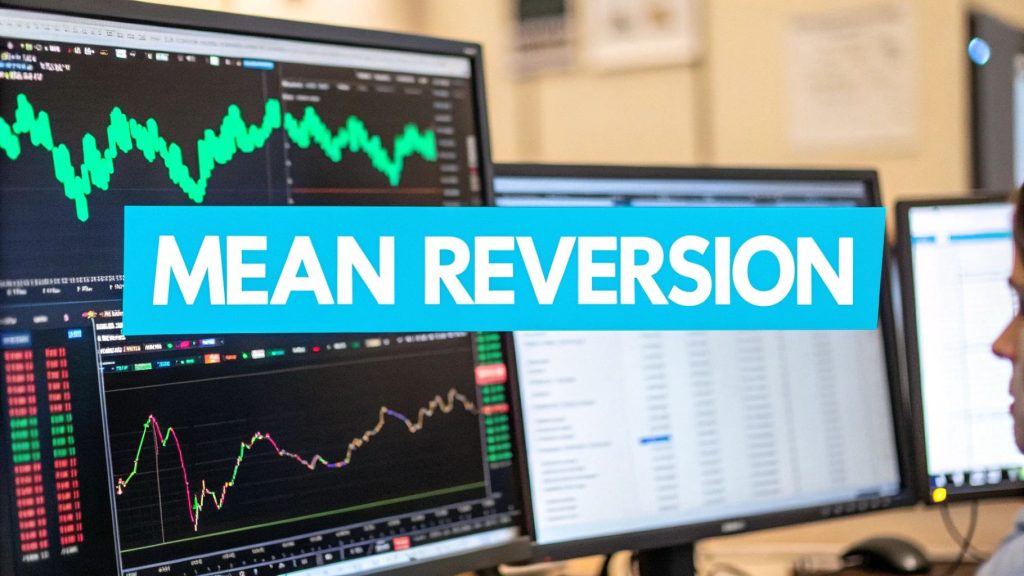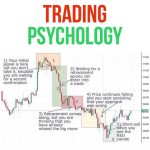
By ATGL
Updated November 26, 2025
Mean reversion trading appeals to investors and traders who prefer systematic, rule-based approaches. Instead of chasing fast-moving breakouts, you focus on situations where price has moved too far away from its typical range and is statistically likely to revert back toward an average. When used carefully, this style can complement momentum methods and provide a more balanced framework for portfolio management.
At a high level, mean reversion trading assumes that markets often overreact in the short term. Prices may drift significantly above or below a fair value range due to short bursts of enthusiasm or fear, then gradually return toward a central tendency. Your objective is to identify those extremes, execute entries with defined rules, and manage risk until price normalizes.
This article explains what mean reversion is, outlines the statistical logic behind it, describes commonly used tools, and then presents seven practical tips to help you apply mean reversion trading strategies in a disciplined way.
What Is Mean Reversion Trading?
Mean reversion trading is a strategy based on the idea that prices tend to move back toward a long-term average after deviating significantly from it. In simple terms, when price trades far above its historical mean, it may later decline toward that level, and when it trades far below, it may recover.
The “mean” in this context is usually a calculated average, such as a simple moving average (SMA) over a chosen period. Traders observe price behavior around this reference line to identify potential overbought or oversold conditions. When price stretches far from this average, you interpret the deviation as a potential opportunity for a reversal back toward that mean.
In practice, mean reversion trading often involves:
- Identifying a reference average (for example, a 20-day or 50-day SMA).
- Measuring how far current price has moved away from that average.
- Determining whether the deviation meets criteria for a possible reversal.
- Entering trades that anticipate a move back toward the average.
- Exiting when price has reverted, or when risk rules are triggered.
While the concept is straightforward, effective implementation requires careful parameter selection, an understanding of market regimes, and a strong focus on risk control. For more context on systematic methods, review Algorithmic Trading Strategies, which outlines broader quantitative approaches.
The Statistical Logic Behind Mean Reversion Trading
The logic behind mean reversion arises from both statistics and market behavior. Many financial time series exhibit a tendency to oscillate around a central value, rather than trend endlessly in one direction. Short-term moves can be influenced by sentiment, news, or liquidity imbalances, but over time fundamental forces often reassert themselves.
From a statistical perspective, the idea relates to regression toward the mean. When data points are temporarily extreme, subsequent observations are more likely to be closer to the average. In market terms, this may represent overreaction that later corrects.
However, mean reversion is not universal. Strong trends can persist for long periods, and prices can remain away from their average longer than expected. This limitation is critical. A mean reversion trading strategy that works well in range-bound markets may perform poorly in a sustained trend where price continues to move away from the mean.
A practical takeaway is that mean reversion should not be applied blindly. It needs filters for trend strength, volatility, and market regime. Understanding these constraints is essential before you design entries and exits.
Tools Traders Use to Identify Reversion Setups
Several technical tools help you quantify how far price has moved away from its recent average and whether a reversion scenario may be forming. Mean reversion trading strategies commonly incorporate at least one of the following:
Simple Moving Averages (SMA)
An SMA smooths price over a defined period, providing a baseline. The distance between current price and the SMA can indicate how extended a move has become.
Bollinger Bands
Bollinger Bands plot a moving average with upper and lower bands based on standard deviations. When price touches or moves beyond the outer bands, it may signal extreme conditions relative to recent volatility.
Relative Strength Index (RSI)
RSI measures the speed and magnitude of recent gains and losses. Readings traditionally above 70 suggest overbought behavior, while readings below 30 suggest oversold levels. Combining RSI with moving averages can improve context.
MACD (Moving Average Convergence Divergence)
MACD compares short- and long-term moving averages and is often used to confirm shifts in momentum. In mean reversion trading, it can help distinguish between temporary exhaustion and genuine trend continuation.
These tools do not guarantee outcomes, but they provide structure. If you want a deeper review of indicator selection and configuration, see TradingView Indicators and Trading with RSI and MACD for more detail on how traders implement them in practice.
Best Mean Reversion Trading Strategies for Active Traders
To move from theory to practical application, you need structured rules and disciplined execution. The following seven tips will help you develop a more reliable mean reversion trading strategy and avoid common pitfalls.
Tip 1: Clearly Define Your “Mean”
The first step is deciding which average represents the “mean” you expect price to revert to. Many traders choose a 20-day or 50-day simple moving average for short- to medium-term setups. Others might use an exponential moving average (EMA) to weight recent prices more heavily.
Your chosen parameter should match your trading horizon. A short-term mean for intraday or swing trading will differ from one used in longer-term mean reversion strategies. Backtesting or historical review can help you decide which length aligns best with your style and the instruments you trade.
Once defined, use this mean consistently so you can objectively compare new setups with past trades.
Tip 2: Quantify the Deviation, Do Not Rely on Visual Impressions
Mean reversion trading benefits from objective thresholds. Instead of reacting when a chart “looks extended,” quantify how far price has moved away from the mean.
You can measure deviation as a percentage move away from the moving average, or in terms of standard deviations. Bollinger Bands, which are built around the concept of standard deviations, are commonly used for this purpose. For example, you might only consider trades when price is more than two standard deviations away from the mean.
By defining these thresholds numerically, you reduce subjective judgment and maintain consistent criteria.
Tip 3: Filter Out Strong Trending Markets
One of the most important aspects of a mean reversion trading strategy is knowing when not to use it. In strong uptrends or downtrends, price can move away from the mean and remain extended for an extended period. Trying to fade such moves can lead to repeated losses.
To avoid this, incorporate a trend filter. For instance, you might check whether a longer-term moving average is sloping clearly up or down before deciding whether to apply mean reversion logic. If a security is in a strong, established trend, it may be better to use momentum strategies instead.
Crossovers or divergence signals from tools like MACD can also help distinguish between brief overreactions and emerging trends. Combining mean reversion criteria with trend analysis improves overall robustness.
Tip 4: Use Momentum Indicators to Confirm Exhaustion
Mean reversion works best when a move away from the average is not only large, but also appears to be losing strength. Momentum indicators such as RSI are useful for this purpose.
For example, a potential mean reversion buy setup might occur when price is significantly below its 20-day moving average, RSI is in oversold territory, and momentum is starting to stabilize rather than accelerate downward. Conversely, a sell or short setup may emerge when price is extended above the mean, RSI is overbought, and upside momentum is weakening.
You do not need a complex combination of indicators, but you should seek alignment between price deviation and momentum behavior. That alignment increases the probability that the move is near exhaustion rather than mid-trend.
Tip 5: Plan Entries and Exits Around the Mean, Not Perfection
Many traders make the mistake of trying to capture the exact high or low. Mean reversion trading is more about targeting the expected return toward a central value than predicting the exact turning point.
For entries, you can choose to be early or conservative:
- Early entries aim to capture more of the move but come with higher risk if the deviation continues.
- Conservative entries wait for partial confirmation, such as a candlestick reversal pattern or the first move back toward the mean.
For exits, define in advance how close you need price to get to the mean before you close the trade. Some traders exit when price touches the moving average; others use a fraction of the move to reduce holding time. In either case, predefining your exit logic prevents emotional decisions after the trade opens.
Tip 6: Integrate Structured Risk Management from the Start
No mean reversion trading strategy is complete without risk controls. Because prices can continue moving away from the mean, you need clear rules for limiting losses.
Setting stop-loss orders beyond recent highs or lows is one straightforward approach. Position sizing should also reflect the potential distance to your stop, the volatility of the instrument, and your overall risk tolerance. If deviation is large, your stop may need to be wider, which in turn requires smaller position sizes to keep account-level risk within acceptable boundaries.
Structured risk controls reduce the emotional impact of individual trades, support long-term consistency, and protect capital when markets behave unexpectedly. For a deeper framework, refer to Risk Management in Trading for additional guidelines.
Tip 7: Test, Refine, and Automate Where Possible
Mean reversion trading is well suited to systematic and algorithmic approaches because the rules can often be expressed numerically. Before risking significant capital, test your strategy on historical data or in a simulated environment.
Evaluate how the strategy performs in different market regimes: low volatility, high volatility, range-bound periods, and strong trends. Identify where it performs best and where it struggles. You can then adjust your parameters, add filters, or define conditions under which the strategy is disabled.
Once you have a stable rule set, consider partial or full automation, particularly for screening and alerts. Automated scanning using platforms that support custom TradingView Indicators can help you find candidate setups that meet your criteria without constant manual monitoring.
Is Mean Reversion Strategy Profitable?
The profitability of a mean reversion trading strategy depends on how it is designed, the markets in which it is used, and how strictly it is executed. In range-bound conditions where price oscillates around a central value, mean reversion can be effective and deliver a steady series of modest gains. In strongly trending environments, however, the same rules can lead to repeated attempts to fade a move that continues to extend.
This trade-off highlights why mean reversion should not be viewed as universally superior or inferior to trend-following and momentum strategies. Instead, it is most effective as one component of a diversified approach. Traders often combine techniques, using trend filters to identify when to favor mean reversion and when to stand aside or shift to other methods.
Cost of execution also matters. High transaction costs, slippage, and poor liquidity can erode performance, especially for short-term mean reversion setups that seek relatively small moves. Careful instrument selection and realistic assumptions about fills are important in evaluating profitability.
A disciplined trader who applies mean reversion in suitable environments, uses robust risk management, and periodically reviews performance can build a profitable strategy. There are no guarantees, but a consistent process significantly increases the probability of long-term success.
How to Manage Risk and Confirm Reversion Setups
Managing risk and confirming setups are the final layers that turn a theoretical mean reversion trading strategy into a practical, sustainable approach.
Start by deciding how much of your account you are willing to risk per trade and per day. This constraint influences position size, stop placement, and the number of open positions you can hold at once. With those parameters in place, define clear conditions for when a reversion setup is valid. For example, you might require:
- A minimum deviation from the chosen mean.
- A confirming signal from a momentum indicator such as RSI or MACD.
- Absence of a strong long-term trend in the opposite direction.
- Acceptable volatility levels based on recent ranges.
These requirements help you avoid marginal trades where the edge is weak. Over time, applying such filters consistently reduces drawdowns and increases the quality of your entries.
If you prefer a structured environment for building and refining rules-based strategies, you may benefit from a comprehensive educational and tools platform. Above The Green Line focuses on objective, rules-driven trading methods that emphasize both technical setups and disciplined execution.
To explore how a rules-based framework can support your development as a trader, you can review membership options here: https://abovethegreenline.com/memberships/.






